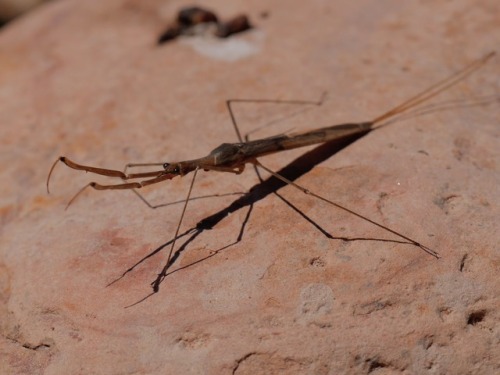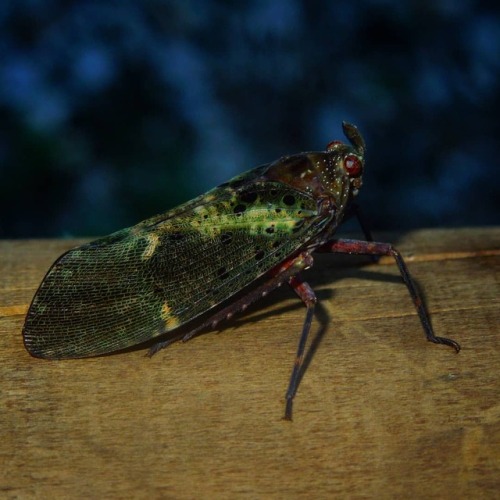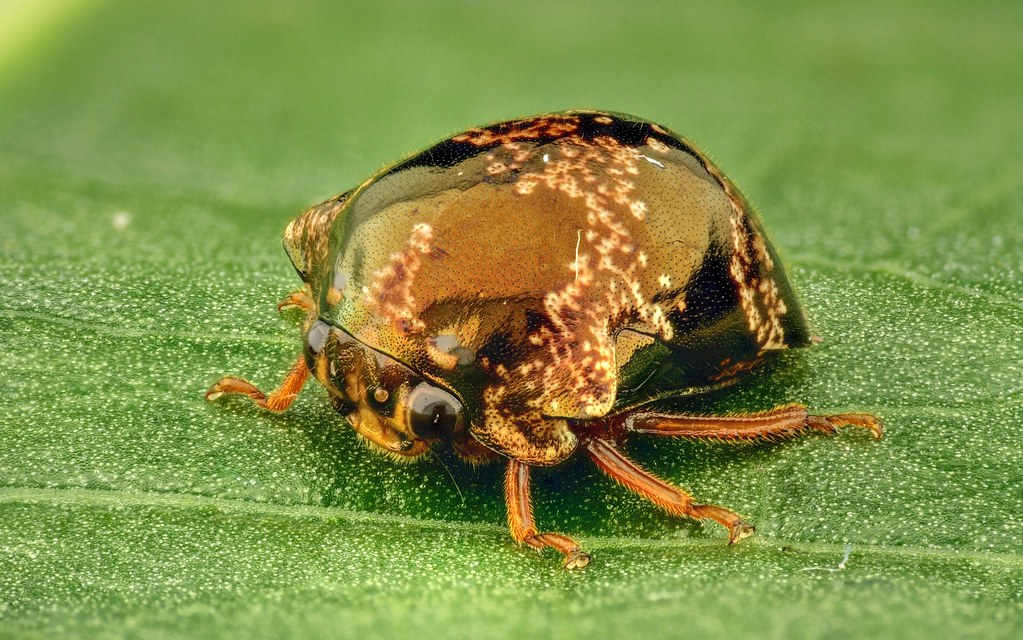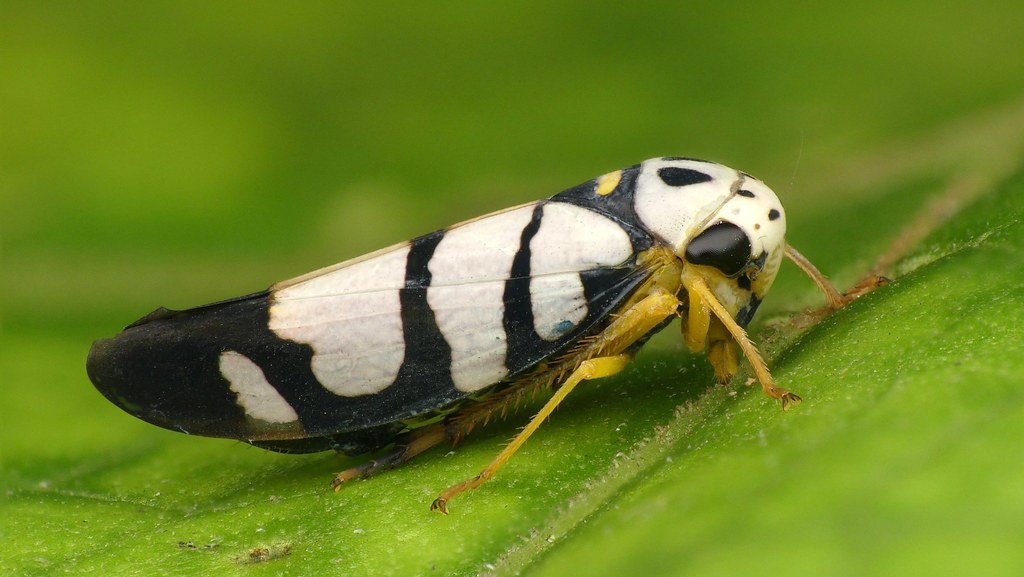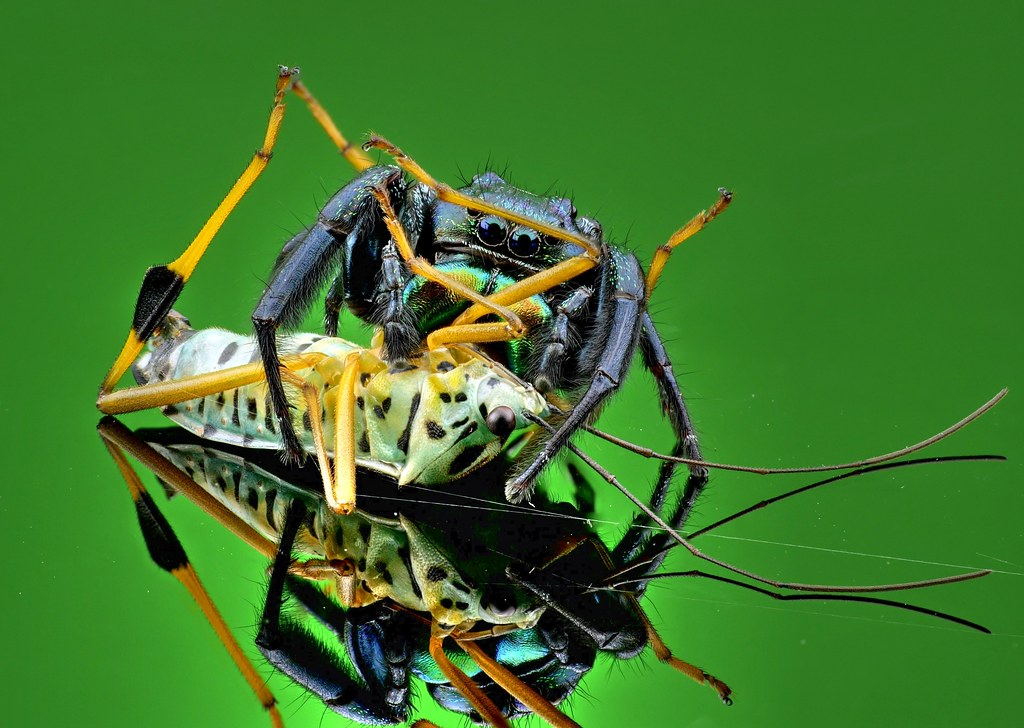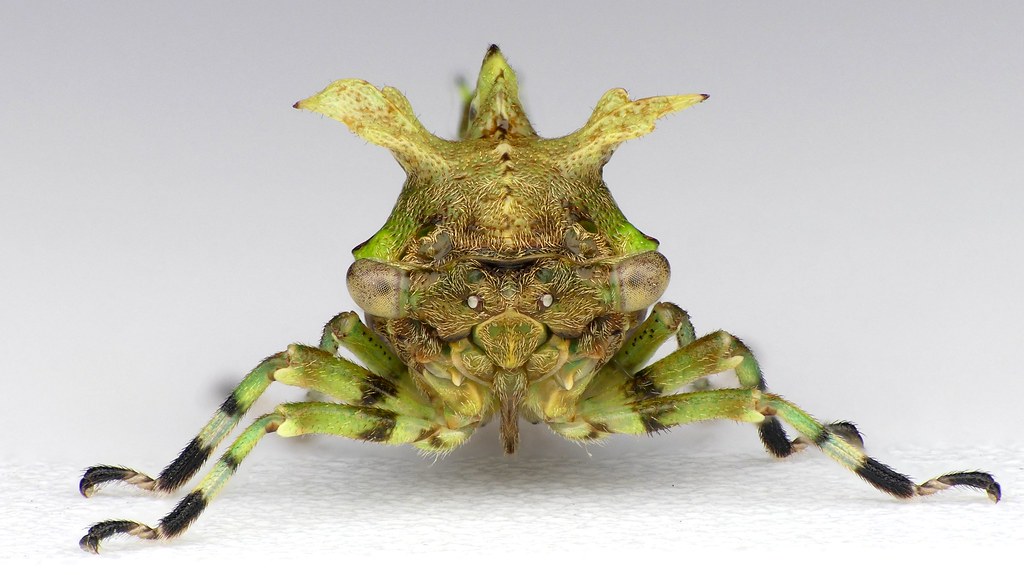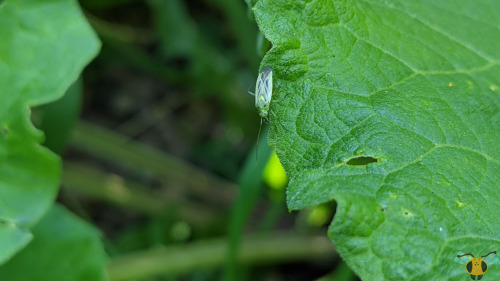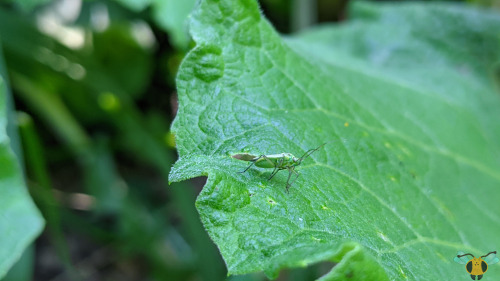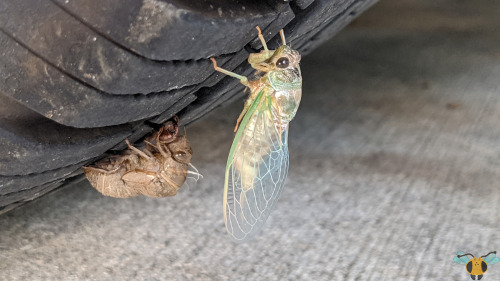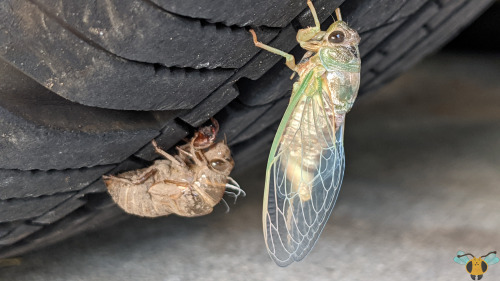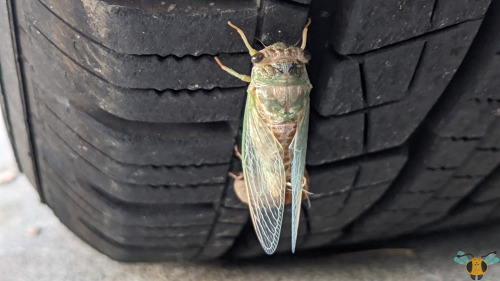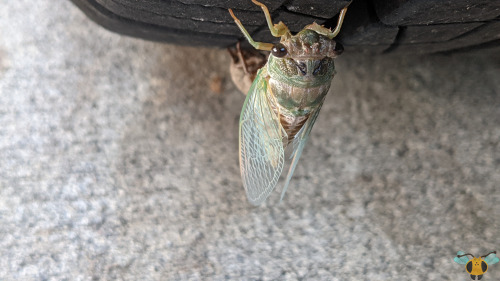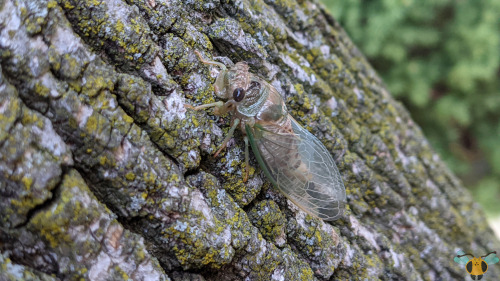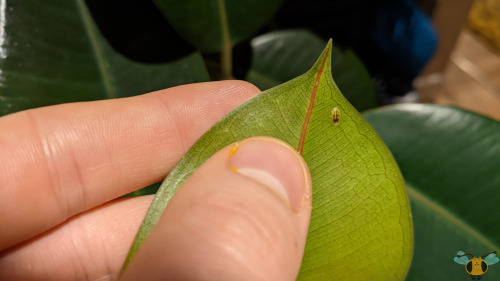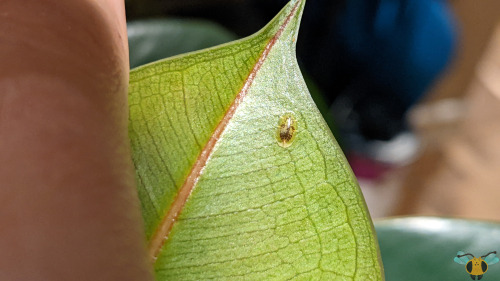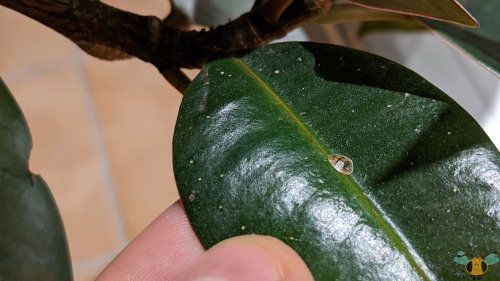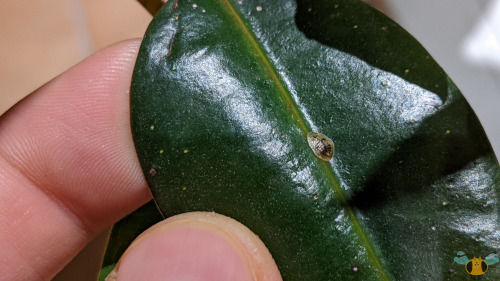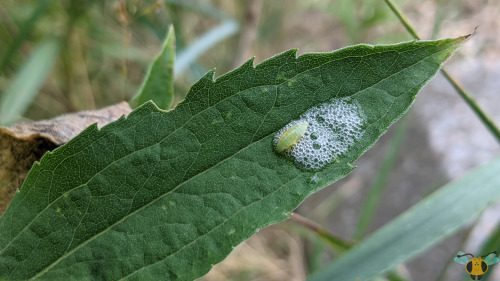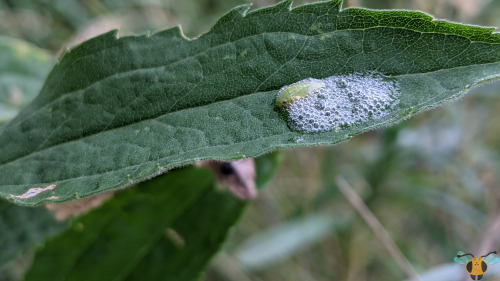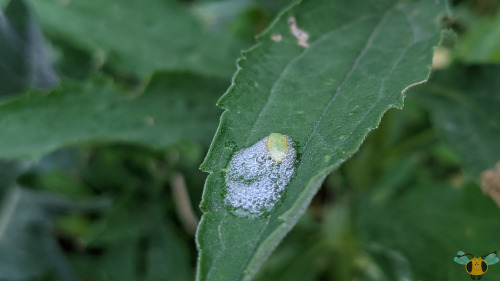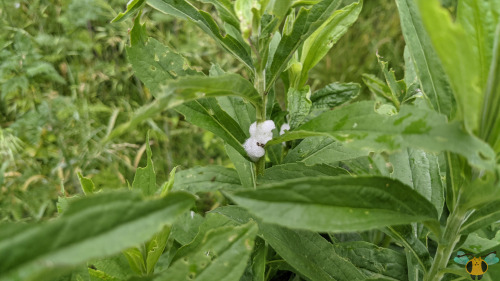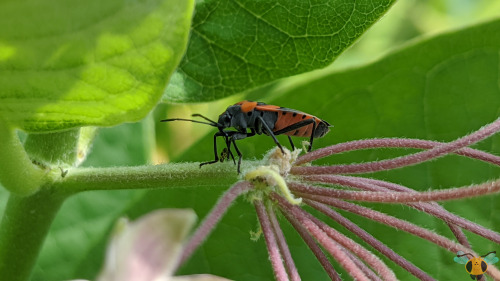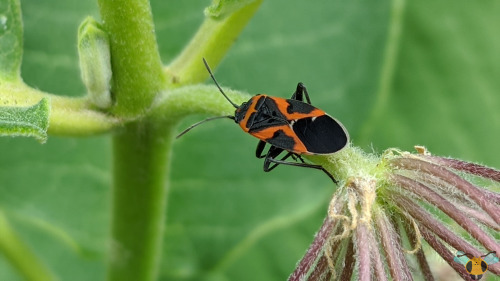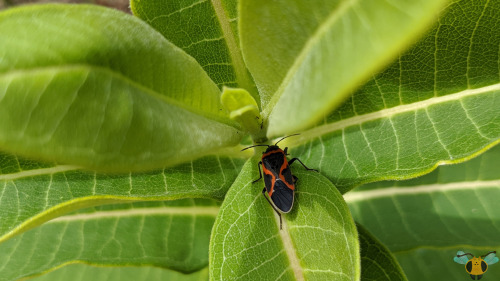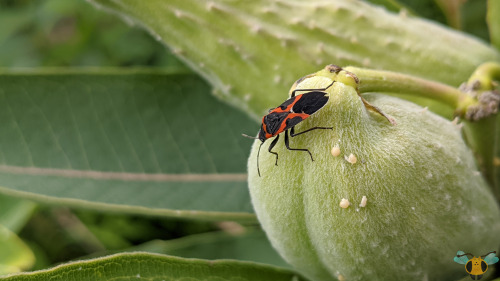#hemiptera
Found this freshly dead swamp/morning cicada (Tibicen tibicen) on the ground. When the thorax (specifically, the mesonatum) is pushed down, the forewings rise. Really interesting!
Did you know that the microstructure of a cicada’s wings is antimicrobial? Read more hereandhere.
Ranatra fusca “Brown Waterscorpion” Nepidae
Lake Inez, Lolo National Forest, MT
May 23, 2017
Robert Niese
There’s something genuinely unnerving about insects viciously preying upon vertebrates, and waterscorpions are superbly specialized for this terrifying task. They sit near the surface of the water, head down, with their elongated, raptorial front limbs outstretched, waiting. Their long paired “tails” remain in contact with the water’s surface like a snorkel, allowing them to breathe while fully submerged. When some unlucky fish or tadpole swims too close, they snap them up like a mantis and immediately stab them with their sucking mouthparts. Their saliva both subdues and begins to digest their prey, allowing them to suck out the animal’s insides. On a completely unrelated note, this individual looks worse for wear, which led me to discover that adults actually overwinter in lakes and ponds here in Montana – not an easy task considering that most bodies of water freeze-over completely at some point. So apparently they’re indestructible AND hyper-specialized predators. Thank goodness they’re only five inches long.
Post link
cotton stainer nymphs (Dysdercussuturellus,seed-feeding hemipterans best known for feeding on cottonseeds) squabbling over fallen seeds from a portia tree
(Florida, 2/6/21)
Chinese Insects and Spiders
…..and more
“TRUE” BUGS of China
Members of the Hemipteran suborder Heteroptera are known as “true bugs”. They have very distinctive front wings, called hemelytra, in which the basal half is leathery and the apical half is membranous. At rest, these wings cross over one another to lie flat along the insect’s back. These insects also have elongate, piercing-sucking mouthparts in which the mandibles and maxillae are long and thread-like, interlocking with one another to form a flexible feeding tube (proboscis) containing both a food channel and a salivary channel.
The immature stages of the heteropteran true bugs (nymphs) structurally resemble the adult form but are always lacking wings.
True bugs are generally well-known and include the stink bugs, assassin bugs, shield bugs, squash bugs and the aquatic water boatmen.
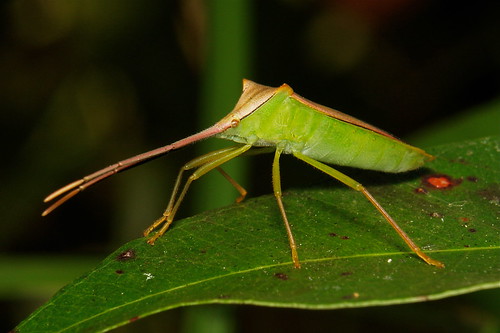

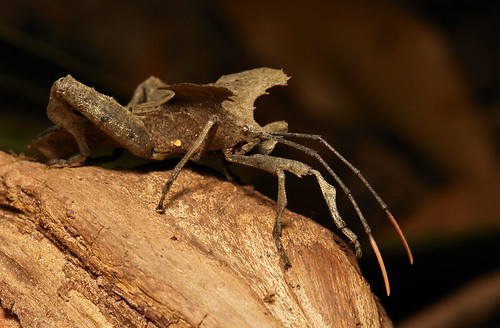

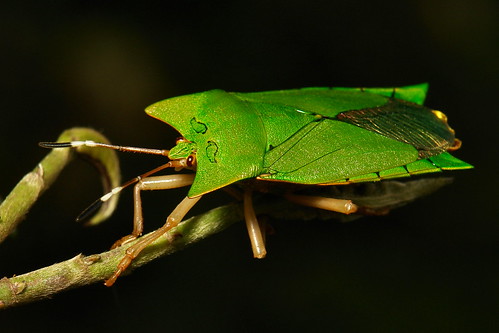
Click images to see identification (linked to their respective Flickr pages).
See others in the series of “TRUE” BUGS of China tumblr posts HERE.
bySinobug (itchydogimages) on Flickr.
Pu’er, Yunnan, China
See more Chinese true bugs and hoppers on my Flickr site HERE…..
Post link
A lantern bug let me take its picture.
#CostaRica #biodiversity #insects #arthropodsanonymous #lanternbug #hemiptera #fulgoridae #insectsofinstagram #macro #forest #ecology #insect_macro
Post link

Bug of the Day
This little nugget is a pecan spittlebug, Clastoptera achatina. South of here, it attacks pecan trees, and can sometime reach pest levels. Here where I live, there are no pecan trees, so this species uses hickory trees as a host instead.

Bug of the Day
OMG How many photos do you take of something that Will. Not. Stay. Still before you give up. 20? 30? Eventually I gave up and tried to pick the little jerk up and took this one last shot (ok, last 4 shots) and this was the best I could do. Turned out to be a Dictyopharid planthopper, Scolops angustatus. Very cool little planthopper, too bad he apparently knows it ;-).


Bug of the Day
Always awesome to find buffalo treehoppers at the lights - this one is genus Stictocephala.

Bug of the Day
That time where I went sweep netting in my yard and only “caught” this stilt bug that crawled into the net while it was sitting on the ground…
Females of giant water bugs will lay their eggs on the backs of the males, who attend to the eggs by using their hind legs to brush oxygenated water onto them.
You may have also heard giant water bugs referred to as “toe biters.” They can indeed inflict some serious pain for their size if not properly handled, and even though they do eat species much larger than they are, humans are not typical fare.
We would often find these opportunistic feeders eating the larval fish in emigration traps in the wetlands of the St. Lawrence River. Can’t blame them for happening upon an easy meal.
Genus: Belostoma
Family: Belostomatidae
Order: Hemiptera (true bugs)
Collected on Nine Mile Creek, Onondaga County, NY.
Post link
Belostoma sp., in the Giant Water Bug family (Belostomatidae), are voracious predators. Typically they hang down from vegetation, with only their retractable breathing straps (located on the tip of their abdomen) above water. When prey get close they use their raptorial front legs to grab their meal and secure it.
Giant water bugs are strong swimmers, and will also actively pursue prey. If their target is on the large side they will hold on to it while it swims about, slowly killing it with poisonous salivary enzymes.
They will consume just about anything they can latch onto: insects, tadpoles, frogs, fish. There are even reports of finding giant water bugs latched onto small birds.
Genus: Belostoma
Family: Belostomatidae
Order: Hemiptera (true bugs)
Collected on Nine Mile Creek, Onondaga County, NY.
Information taken from Voshell, JR. 2002.
Post link
Not the prettiest bug, but a pretty neat one. Metrobates is a member of the water strider family. They spread their enormously long legs to distribute their weight and use surface tension to stay on top of the water.
Order: Hemiptera
Family: Gerridae
Genus:Metrobates
Arbutus Lake, NY
Post link
Treehopper, Chelyoidea intermedia, Membracidae by Andreas Kay
Via Flickr:
from Ecuador: www.youtube.com/AndreasKay
Bee Assassin, Notocyrtus sp., Reduviidae by Andreas Kay
Via Flickr:
from Ecuador: www.youtube.com/AndreasKay
Leafhopper, Calliscarta acuta? by Andreas Kay
Via Flickr:
from Ecuador: www.youtube.com/AndreasKay
Jumping Spider, Parnaenus cyanidens & Leaf-footed Bug by Andreas Kay
Via Flickr:
from Ecuador: www.youtube.com/AndreasKay
Treehopper, Membracidae by Andreas Kay
Via Flickr:
from Ecuador: www.youtube.com/AndreasKay
Treehopper, Smerdalea circumflexa by Andreas Kay
Via Flickr:
from Ecuador: www.youtube.com/AndreasKay
Eastern Boxelder Bug - Boisea trivittata
I’ve developed a large stockpile of Boxelder Bug pictures to upload over the years, but despite how frequently I find them in my area, They’re some of the first insects to be food in the early spring (crawling in the leaf litter) and some of the last insects to grace the autumn (eventually making their way to the leaf littler); 2 generations make them easy to document and photograph. I’ve never sought to record them in motion. With today’s video, that changes. Taking a walk in a wooded area, I noticed that there were Boxelder Bugs galore! Not quite swarming, but there was tremendous activity on the goldenrod plants and in the dried grasses. Perhaps they were looking to secure territory and mating spots? The timeline would fit, and hopefully the nymphs are positioned near a suitable plant to satisfy them, While named after their host plant, it seems that maple tree juices are a source of food for them too! With this video, we can examine and observe how the insect moves on and reacts to the surfaces it struts along. While exploring the hand was a new experience for it, it seemed more than eager to return to the young goldenrods and hide from me. What interested me the most when revisiting the footage at home was how the insect’s antennae orient themselves when the Bug is on the move and at rest. It’s always sensing where to go next and getting a feel for its surroundings.
Video was recorded on May 19, 2022 with a Google Pixel 4. As well, B. trivittata will be known as the Eastern Boxelder Bug rather than just Boxelder Bug. This is to futureproof for later Boxelder Bug posts with new species. Prior posts have been adjusted to the reflect this change.
Two-Spotted Grass Bug - Stenotus binotatus
A green area filled with green grass, green leaves, and a certain green insect skitting around in this green world. With a bright green body, this specimen could have a much easier time hiding in your garden or the meadows that it calls home. You’d probably be better off searching for it in the meadow as there’s plenty of tall grasses for it to stick its rostrum into and enjoy. Yes, the Two-Spotted Grass Bug does in fact feed on grasses, but not the blades of grass that are seemingly more appetizing. Leaving the blades for the Grasshoppers to munch, this verdant Plant Bug uses its mouthparts to take nutrients from the clustering flowers of grass. As well, it isn’t too picky about the grass flowers it chooses to feed on whether a nymph or a full grown adult (like this specimen). The major difference is how to get to and from the food it needs since the nymphs lack wings. While known for feeding on grasses, they don’t seem to be generalists as they’ve been found feed on tree flowers too. With zebra grass growing in our neighborhood, I wonder if they have taken to that?
While named after the spots on their thorax plate, you could be forgiven for missing them by looking at the stripes that run down their wings. They certainly are lovely, but you have to look for those spot markings too. With look-a-like insect such as the Alfalfa Plant Bugand Ilnacora malina,it’s helpful to be sure which insects are flying around the meadow. With respect to the latter which is a dark green with a darker head, the Two-Spotted Grass Bug tends to be a paler green color with green on the top of its head. Although sometimes you may find a yellow-colored Grass Bug! What’s this! It seems that male S. binotatus tend to fall more on the yellow side while females tend to have that pale green color! Also, while I’m not totally sure, it seems that males have more their spots become gradually more prominent as they age, practically connecting with the markings on their back into one long line. I’ll need to find and review more specimens to be sure, and find more in person too! As with every insect I photograph, if I can find more, you’ll find them here, and I do sincerely hope that you enjoy them!
Pictures were taken on June 16, 2021 with a Google Pixel 4.
Post link
Dog-Day Cicada - Neotibicen canicularis
Well, I hinted at this in a very important earlier post that honors someone who will always be with us, and here it finally is! Insects are very resourceful when it comes to entering adulthood, even if it means using manmade structures to get the job done. It may be topical to share this on Earth Day (with an insect that spend most of its life in the earth) and take a small, unconventional glance on how insects and humans interact and share the planet. I agree that other avenues such as climate change, habitat destruction, biodiversity changes and examining more significant insects (Beetles,Butterflies&Honeybees) are far more relevant, but I’d like to share the short encounter with a Cicada molting using a car tire. It’s an unexpected example of the natural world using human creations. I’ve seen Cicadas using wooden benches and concrete barriers too, but at least those are similar to trees and stones. Tires are something completely foreign, but it does offer a good grip for the nymph’s old shell to grab and hold on as it molts. This nymph must have been extremely determined to climb up the curved slope of the tire’s bottom and climb against gravity! Amazing as this new molting post is, I don’t think Cicadas would make it a yearlong habit when aforementioned natural structures are available.
Talking about nature, insects are some of the best environmental caretakers we have, and it would benefit us to learn a little more about them and realize how different insects contribute to the ecosystem and food webs. Not to mention, appreciating the contributions of every insect order, rather than just writing them all off as pests. Insects help us in more ways than we can imagine, but the wrong insect in the wrong place (e.g. an invasive specie) can be just as detrimental so we must be respectful and careful with our interaction with them. Their lives deserve all the beauty and triumph that our lives do, and that might mean a little help for them. Even caring for trees and wildflowers, cleaning up where we can and being careful with biological debris such as leaf litter and fallen logs. Nothing too intrusive unless something needs a major correction. Just a subtle, guiding hand. With this Cicada friend, I just found the adult insect stretching its wings and hardening its body, missing the molt process. It was relatively fresh as while the wings were almost ready, the body’ still needed more time to darken. I didn’t know how long the Cicada friend would hang around for, but I didn’t want to leave it alone, so I picked it up and placed it on a nearby tree. Perhaps it’s for naught, but at least that Cicada won’t have all that effort ruined by being run over. After it began to move around and climb upwards, I continued with my walk. Hopefully that Cicada enjoyed a wonderful summer!
Pictures were taken on August 18, 2021 with a Google Pixel 4.
Post link
Brown Marmorated Stink Bug - Halyomorpha halys
So I’m working at my desk, doing research for an online course and I hear a noise. It sounds like a low buzzing, and it also sounds much larger than an Asian Ladybug, a more common visitor in my warm when spring’s warmth arrives. I turn around, that there’s a large flying body zooming around the lights and flying around the room with great haste! I thought it might be a Western Conifer Seed Bug since they’ve appeared in my room before, but it was flying too quickly to be sure. Couldn’t tell until it finally settled down, but there’s something about insects and light, and it keep circling the lamps. By this point, I had closed the door to prevent escape into the house. After a few minutes of flying around and tension growing, it crashed behind a set of drawers. Searching for it, I found the visitor on my tennis racquet, upon which I got a good look at it. A Stink Bug has awoken up for the spring! When I went to get my phone, the little Bugger took flight and began to buzz around the room again! Argh!! At least we know what it is now.
While it has a compact, shield-shaped body, it can be startling to see the full length of the wings for that split second before flight. When at rest, Stink Bug wings are folded against the abdomen, the forewings conceal the hindwings until it’s time to fly. It just wouldn’t be possible to maneuver that wide body without powerful wings, so when it’s time to go, the wings unfold out and get flapping. Getting back to the story, it resumed flying around the room aimlessly, eventually crash landing on top of the drawers this time. No slowing down, just crashing to an abrupt stop! Thank goodness an insect’s armored body allows for that, even if it may be too much for some other body parts to handle. Poor thing was missing a leg and an antenna. It could be tough to fly without all your instruments working. I picked it up in a glass and put it out the window (and without any spraying of stink) so that it wouldn’t be a bother indoors. Just a little story for today. Try not to be too nervous about the insects that decide to spend the winter in a warm house. They don’t mean to be bothersome, but they just can’t stand the cold. Quite relatable!
Pictures were taken on April 12, 2022 with a Google Pixel 4.
Post link
Soft Brown Scale Insect - Coccus hesperidum
Building off of last week, it seems there’s a theme of small insects that like to hide safely among the plants as they feed and enjoy the day. This time, we cover a troop of insects that have endured through the winter by concealing themselves in one of our house plants. Since winter is too harsh from the rubber plants to survive outside, they are brought indoors until temperatures go up again. That’s all well and good, but the last few years have brought a share of pests inside too! Over the last few years, it was Whiteflies that snuck in and ruined a few smaller plants, while the rubber plants endured. This year, honeydew secretions were found staining the leaves, a sign of infestation, but no Whiteflies or similar insects. Looking a little closer, the tiny culprits were found! It may be hard to believe, but the oval patches on the leaves are insects. Yes, really. They’re a bit unconventional, but underneath that scale-like covering, there is the body of an insect, albeit some body parts like the legs or antennae are smaller than usual. With that in mind, hopefully you have an overall impression of their size compared to my thumb.
Scale Insects as they’re called have a waxy shell that hide the true insect underneath. The Soft Brown Scale can be identified by the brown patterns on the shell, but the best way start identifying a Scale is to determine the plant they feed on. Like Whiteflies and Aphids, they are parasites that spend their lives feeding on plant fluids, excreting honeydew and siring many young scales to continue the infestation. Some mother Scales are so dedicated that they anchor themselves to a spot on the plant and shield their young with their own body until they are old enough to manage on their own. Males tend to be more mobile with use of wings, but it varies from specie to specie. Though small, unlike Aphids and Whiteflies, their shells protect them from predators, allowing them to aggregate much easier, leading to great concern for their host plant! At first, the honeydew they make is bound to attract Ants to help guard the Scales, giving them the chance to increase their numbers further. Eventually (in similar ways to Whiteflies), the honeydew left behind on the leaves can become a prime target for mould to strike the plant and weaken it. Meanwhile, the Scale hoard grows and they keep feeding! Fortunately, managing Scales is simple, but you’ll need a keen eye to find them. Remember to check in the grooves between leaves, the undersides and even on the plant’s stem or bark. Look for anything that looks like a growth or a bump that looks out of place. Finally, remember to clean the honeydew off all the leaves you can.
Pictures were taken on March 28, 2022 with a Google Pixel 4.
Post link
Meadow Spittlebug Nymph - Philaenus spumarius
Spit! Has someone passed by these plants and purposely spit on them? And more worryingly, how does the spit deft gravity and just hang there on the plant? While you may be tempted to be grossed out at first, the globs of foam on these plants aren’t actually spit. It’s a collected mass of various liquids (which ones will be revealed later) that come together, generating a sticky foam which a family of insects uses to ward off drying out from the elements and avoid predation by staying hidden in the frothy mass. Such a behavior has given these insects the name “Spittlebug.” While I don’t encourage ruining an insect’s hard work in order to get a good image of them, I can recommend patience because you might find one of these insects that escapes from its foam to explore its home briefly. Since the insect is soft-bodied, it can’t afford to explore for too long. It could attempt to make fresh foam like the individual in Pictures 2-6, but a better strategy may be to return to its foam-home or enter the home of another Spittlebug. It’s unclear whether they’d cooperate or fight over ownership of the bubbles, but it may depend on how much room there is to go around.
Even this liquid safety has its drawbacks, however. Since the young insect is in a foamy environment, it needs specialized spiracles (breathing-holes) that are careful not to take fluid in when surrounded. Not much else this squishy little Bug can do until it reaches maturity and gains wings, stronger legs and a more solid body. Upon the final molt, the insect will look similar initially, but turn color from green to brown after leaving the foam and getting a little bit of sun. The individuals on display here aren’t too far away so with a little more feeding and growing, they’ll be ready. To achieve growth into adulthood, the young nymphs will settle on the plant and pierce the stem, drinking the sap from within. The excess of moisture obtained from the feeding is excreted as urine from the rear and incorporated into the production of the foam using specialized glands. Goodness, it’s like honeydew only acrid and nasty to any creature who dares eat it! So yes, is it insect spit? No, it’s much worse than that! It’s diluted insect urine frothed up into a home. Startling to think about, and yet, quite effective at protecting the little nymph. If there’s any consolation, its a boon that the urine is rather diluted and filtered to minimize unwanted effects from grime or pH balance.
Pictures were taken on June 8, 2021 with a Google Pixel 4.
Post link
Small Milkweed Bug - Lygaeus kalmii
With Tuesday’s insect still fresh on our minds (Happy Valentine’s Day), I’m following it up with another black and red insect that has a similar appearance that one. The two are often confused for one another at first glance, but they have their differences in patterning and behavior once you get close enough. Common Firebugs have those large spots on their reduced wings, while today’s subject - the Small Milkweed Bug - has a red “x” pattern with black-colored bordering. Look for little simple eyes on the head of the Small Milkweed Bug too! These are called ocelli, and many other orders of insects have these too! These little ocelli are a big help for insects that need to get around by flying (since they help with the intake of information). However, just because Red Bugs lack ocelli, doesn’t mean they won’t fly, but some of them unfortunately wound up with reduced wings. Today’s showcase however, is a Seed Bug and can make great use of its wings to scale milkweed stalks and make a sudden escape if it’s been found tucked behind a seed pod. Though they may look similar to the Common Firebug (among others), their nesting and feeding habits have some differences.
You may see aggregations of the Small Milkweed Bug in an area dominated by flowers or scrounging around on the milkweed stalks, but the numbers will be much less. You’re more than likely to only find one or two, or maybe a mating pair? As they roam around the milkweed stalk, they search for the most valuable food sources they can: flowers and seeds! Some of the individuals in these photos have struck liquid gold! These milkweed flowers are ripe for the drinking, and using their straw-like rostrum, taking a sip can be done in a snap! Yeah they really like to get in there. While milkweed is the best choice here, they can drink from other flowers if they need to, especially if other insects swoop in a take all the nectar before they can. The milkweed pods are the next best target for all the seeds they house, making them valuable for eat and to lay eggs on. Depending on how fast your milkweed grows, you may want to monitor for these insects, but you can rest assured they pose little harm to your milkweed plants. They’ll share the territory with other milkweed dwelling insects, but it’ll be up to all of us to see if they bully other insects away from the delicious flower nectar.
Pictures were taken on July 2, 12, 21 and August 2, 2020 with a Google Pixel 4.
Post link
Shield-backed Bug - Pachycoris klugii
Pachycoris klugii (Heteroptera - Scutelleridae) is a common species in Mexico and Central America that in the past has been misidentified as P. torridus. It is an aposematic species that is brightly colored, with metallic green, and yellow, orange, or red spots. Extensive variation was observed in the color pattern of adults.
There have been several reports of maternal care in Heteroptera, according to Wilson (1979) it corresponds to a subsocial behavior in which the parent offers shelter with its body, carries the nymphs around on its back or venter, or simply stands close by. Maternal behavior was related to egg parasitism, habitat and host plant phenology.
Photo credit: ©Eduardo Axel Recillas Bautista | Locality: Hidalgo, Mexico (2008)
Post link
Lantern Bug - Pyrops spinolae
Lantern bugs are planthoppers (Hemiptera - Fulgoridae), typically arboreal, most often associated with a specific host tropical tree and/or vine.
The lantern bugs are so named, incorrectly, because of a head prominence of some species (i.e. Pyrops) resembling a Pinocchio like “nose” that was thought to emit light. Of course this is not true, it does not emit light. Pyrops spinolae (pictured) is known from Thailand, Vietnam and India.
Photo credit: ©tajong | Locality: Khao Sok Thailand (2015)
Post link

